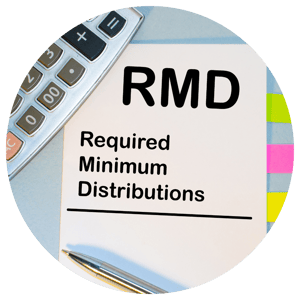What are required minimum distributions, and why do you need to make them? Required minimum distributions (RMD) are funds that must be removed each year from pre tax-funded retirement plans after you reach the required age, which is now 72. Without RMDs, the possibility exists for an inheritance scenario whereby these funds might never be taxed. The required minimum distributions were instituted to help ensure that at least a portion of this income from retirement plans is taxed.
What retirement plans must make the  required minimum distributions?
required minimum distributions?
In general, the retirement plans that must make the required minimum distributions are those in which the income was tax-free (pretax) when put in. These include the following:
- profit sharing plans
- traditional IRAs
- SIMPLE IRAs
- SEP IRAs
- 457(b) plans
- 401(k) plans
- 403(b) plans
- TSPs
- any other contribution plans as defined by the IRS
Now, any amount withdrawn will usually be taxed at normal income rates, unless it had been taxed prior. Some Roth account qualified distributions will not be taxed. Those with multiple accounts will need to determine in which RMDs are required and calculate amounts for each separately.
Will there be RMD for 2021?
Yes, there will be RMD for 2021, unless new legislation is enacted. Required minimum distributions were put on hiatus for 2020, due to the COVID-19 pandemic, under the Coronavirus Aid, Relief, and Economic Security Act, known as the CARES Act. The RMD has been reinstated for 2021.
What are the new rules for RMD?
Before the CARES act mentioned above, RMDs had to be first taken for the year in which the recipient reached 70 1/2 years of age. The new rules permit the taxpayer to wait until April 1st of the year which immediately follows that in which they turn 72, although they can make the distribution earlier. All subsequent distributions are required by December 31 of the appropriate year.
Care should be taken here, because if you delay until that April date the first year that you are required to make the RMD, with another RMD due by December 31st, it effectively gives you two distributions in the same year. This could adversely affect your taxes. There are some employer-qualified plans that allow deferral of RMDs for those who are still working at age 72, although the 5% taxpayer company ownership rule applies. The 10-year payout rules are now in effect for non-spousal beneficiaries of persons who died in 2020 or later.
 How do I calculate my RMD for 2021?
How do I calculate my RMD for 2021?
Whatever your account balance is in your retirement accounts on December 31 of the prior year is the number your calculations are based on. So:
- Determine the balance of your appropriate account as of December 31st of the immediately prior year.
- There will be a distribution factor on the IRS table for your age during the current year.
- The balance should be divided by this appropriate distribution factor number to find your required minimum distribution.
For example, say you turned 73 on July 15th of the current year. Your qualified retirement account has a balance of $300,000 on December 31.
You would calculate the required minimum distribution using the IRS “Uniform Lifetime Table:”
RMD= $300,000/24.7= $12,145.75
This is the amount you would need to withdraw from your retirement account for the RMD. Note: There are different tables for beneficiaries, depending upon status.
If I don't take the RMD, is there any penalty?
Yes, there is a stiff penalty for not making the RMD at the proper time and in the correct amount. Any RMD amount not withdrawn from a retirement account at the required time may be assessed a penalty of 50% of that amount. However, reasonable error is a basis for waiving the penalty if you can show that changes have been instituted to rectify the possibility of further error. This requires filing a form 5329 with a letter of explanation, however, so the best path forward is definitely to ensure that your RMD is taken in the correct amount at the proper time.
Other Tax Considerations
If you plan to make charitable contributions during the year, the RMD may be used for this purpose, which could be a tax deduction, if qualified charitable distribution (QCD) rules are followed. The Roth IRA does not require minimum distributions as the Roth 401(k) does. It is possible to roll funds from the Roth 401(k) into a Roth IRA, which may avoid the necessity of fulfilling the RMD requirement. Also, care should be taken to check the effect of the required minimum distribution amount on the taxable portion of any Social Security benefits.
Your CPA Tax and Financial Professionals
There will almost certainly be additional changes to RMD rules in upcoming years. Due to the complexities involved, it is often best to trust tax implications and calculations to the experts. Contact the team at Chandler & Knowles CPAs to ensure your tax and financial situations are always handled in the most advantageous professional manner.

